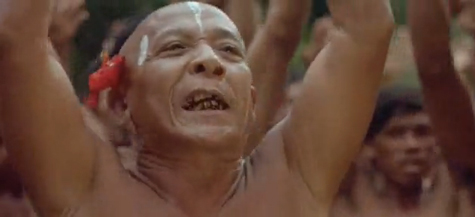Human Flower Project
Kecak: Invented Tradition
A wordless film of global wonders includes an astonishing Balinese dance. What’s hibiscus doing here?

Kecak performers, with hibiscus behind the ear, in Bali
At our beloved downtown brocade-walls and bad-velveteen-seats movie theater – the Paramount – we caught the late show of Baraka. This is Ron Fricke’s 1992 cinematic shriek, shot in 70 mm – a God’s eye view of flaming oilfields in Kuwait, drowsy Japanese monkeys, Rio slums, flamingo herds ad magnificum.
Many have written that the wordless film glorifies the natural world and condemns humankind’s waste and cruelty. That’s not how we saw it. Instead, Baraka, with its immense vistas and bellowing soundtrack, strikes us as a testament of power —both human and non-human. It witnesses that the forces of culture are as resounding as volcanoes and waterfalls.
Surely the strongest scene of the film is the three minute performance of kecak, a Balinese art that, to the uninitiated, is compelling and bizarre. (The youtube clip is lively but not much like seeing and hearing this interlude in the dark on the big screen.)
The Balinese “Monkey chant,” as it’s often translated into English, takes place in a circular open-air stage and includes “upwards of 60 men dressed only in sarongs, each with a red hibiscus planted behind his ear.” Following a choral leader with throbbing motions and clacking sounds, they (purportedly) re-enact a tale from the Hindu Ramayama.
Honestly, we couldn’t follow any storyline, but as post-modern entertainment, so much the better: Kecak is one big “Wow!” The strength and the shallowness too of Fricke’s majestic film is that lacking any context, the glorious imagery and booming audio become strangely flat. At the end of 90 minutes, we’ve been stuffed with beggers and eclipses, cigarette factories and throngs at Mecca, snow-capped peaks and Tokyo subways. It’s a sensory pig-out but, eliding any understanding, Baraka is guilty of the same mindless excesses it wants to damn.

The kecak leader conducts the “monkey chant” at Tampaksiring temple, Bali, Indonesia
Photo: youtube/Barak
We were startled to discover that kecak, which would seem the epitome of folk culture, was actually a drama invented in the 1930s by Walter Spies (his real name), a German painter and musician who, enthralled with Balinese art, turned a local “trance chant” into this riveting spectacle – a favorite of Bali’s tourists today. So is kecak Bali’s equivalent of the Grand Ole Opry?
Thus far, we’ve found some clues as to the place of flowers in traditional Balinese dance, but we aren’t sure about the hibiscus and its role in the kecak. There are definitely a lot of B&B’s in Bali that use the name Hibiscus.
How much more interesting Fricke’s film would have been if it had also juxtaposed fans streaming from Cowboys Stadium with calls to Muslim prayer, or Beyonce in slow motion with Somali teenagers. Or for that matter Porter Wagoner at the Opry cloaked in sequinned wagon wheels with the tattoos of a Japanese bather. (By the way, despite what Baraka shows, tattoos are frowned upon in Japan’s public baths and may even get you ejected from an onsen.)
As the great Edward Hall concluded, “Culture hides much more than it reveals, and strangely enough what it hides, it hides most effectively from its own participants. Years of study have convinced me that the real job is not to understand foreign culture but to understand our own. I am also convinced that all that one ever gets from studying foreign culture is a token understanding. [To study another culture] is to learn more about how one’s own system works.”—from The Silent Language
Baraka is the most imposing example of hiding we’ve encountered in a long while—try to see it on a really big screen, and bring ear plugs.


Hm, I wonder how many other “folk” arts have been developed by “non-natives”.
Thank you for reviewing the film here. Lucky for me, I can order the film via Netflix.